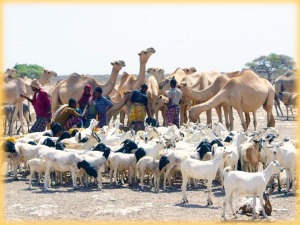Mixed herd of dromedaries and goats, Mauritania. - © C. Euloge. | In endemic areas, livestock rearing and herd management practices increase the risk of PPRV circulating. This is the case when herds are mixed, combining animals with different levels of viral susceptibility. Large herds also are environments with a high risk of PPRV. It also is the case when the movement and gathering of animals promote frequent and repeated contact between animals with unknown disease status. When the usual herding routes (cross-border seasonal transhumance, nomadism) are changed the risk of spreading the virus also is increased. The increased trade movements of live animals, without sanitary controls, between livestock producing countries and areas to consumer countries and areas is contributing to the spread of the virus over long distances. In pastoral societies, local social and cultural practices and human behavior may increase the risk of introducing the disease into as yet disease-free areas.
|






